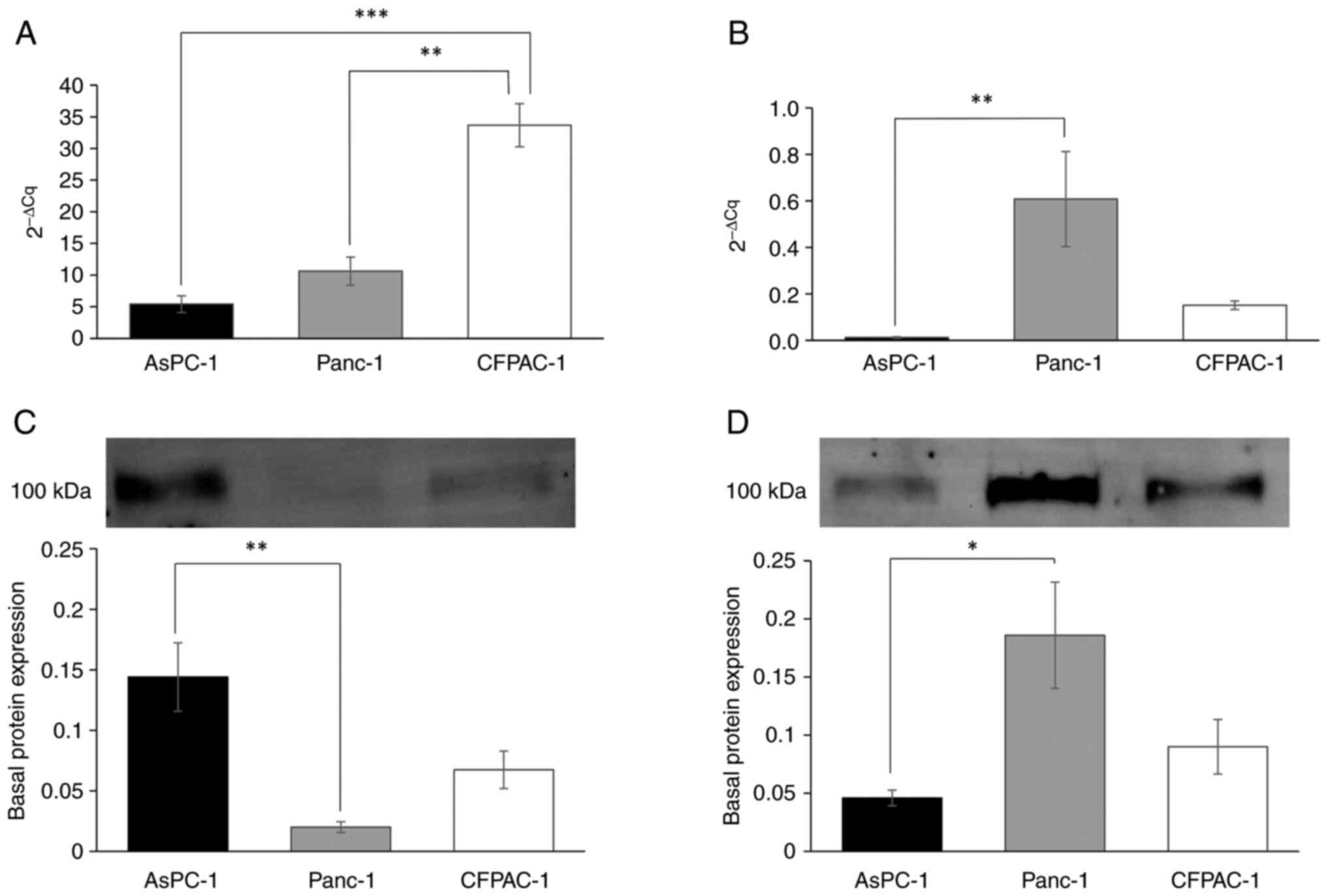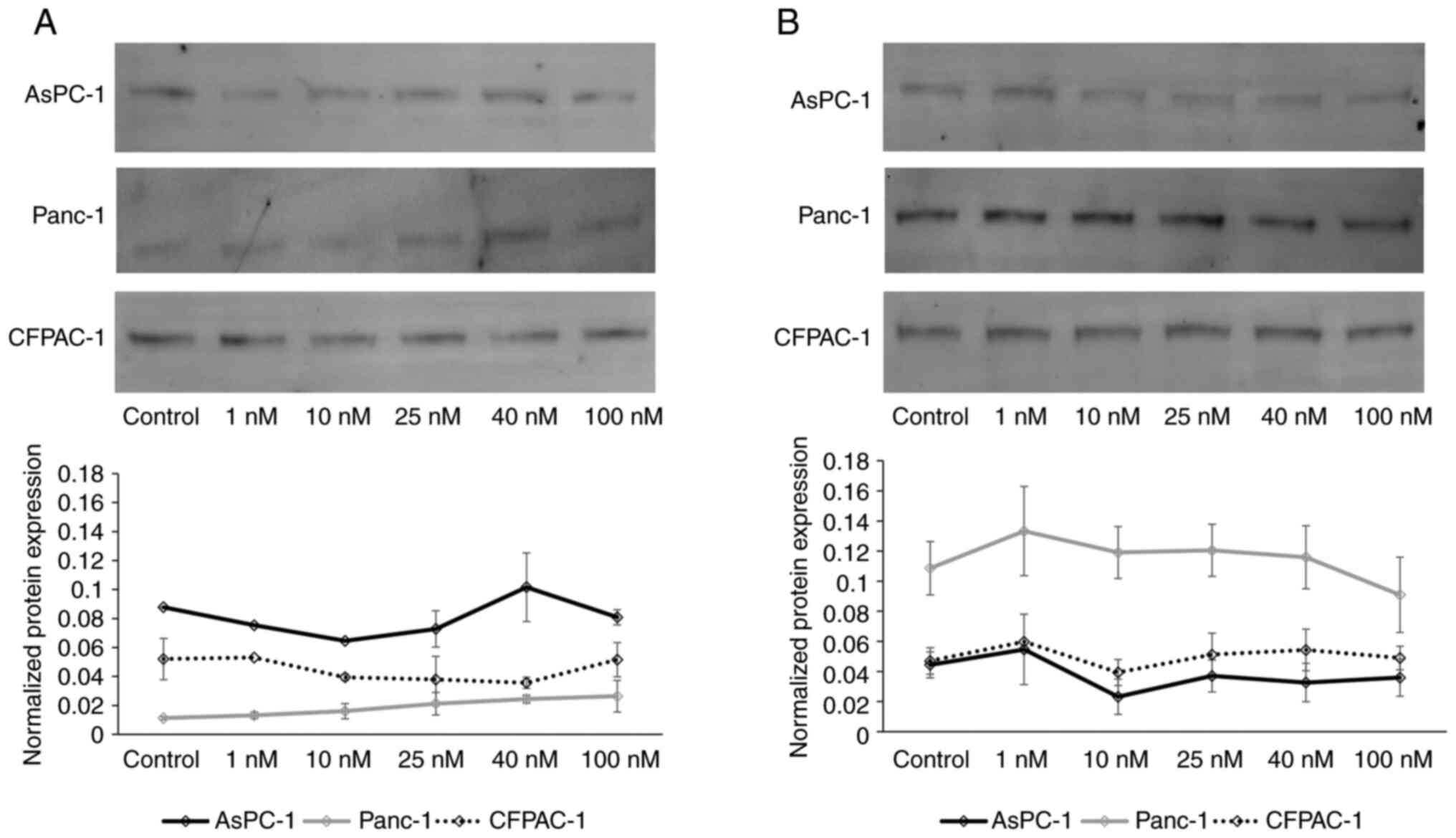|
1
|
Ansari D, Gustafsson A and Andersson R:
Update on the management of pancreatic cancer: Surgery is not
enough. World J Gastroenterol. 21:3157–3165. 2015.PubMed/NCBI View Article : Google Scholar
|
|
2
|
Becker AE, Hernandez YG, Frucht H and
Lucas AL: Pancreatic ductal adenocarcinoma: Risk factors,
screening, and early detection. World J Gastroenterol.
20:11182–11198. 2014.PubMed/NCBI View Article : Google Scholar
|
|
3
|
Pereira NP and Corrêa JR: Pancreatic
cancer: Treatment approaches and trends. J Cancer Metastasis Treat.
4(30)2018.
|
|
4
|
Frankel AE, Eskiocak U, Gill JG, Yuan S,
Ramesh V, Froehlich TW, Ahn C and Morrison SJ: Digoxin plus
trametinib therapy achieves disease control in BRAF wild-type
metastatic melanoma patients. Neoplasia. 19:255–260.
2017.PubMed/NCBI View Article : Google Scholar
|
|
5
|
Coleman DT, Gray AL, Stephens CA, Scott ML
and Cardelli JA: Repurposed drug screen identifies cardiac
glycosides as inhibitors of TGF-β-induced cancer-associated
fibroblast differentiation. Oncotarget. 7:32200–32209.
2016.PubMed/NCBI View Article : Google Scholar
|
|
6
|
Kepp O, Menger L, Vacchelli E, Adjemian S,
Martins I, Ma Y, Sukkurwala AQ, Michaud M, Galluzzi L, Zitvogel L
and Kroemer G: Anticancer activity of cardiac glycosides: At the
frontier between cell-autonomous and immunological effects.
Oncoimmunology. 1:1640–1642. 2012.PubMed/NCBI View Article : Google Scholar
|
|
7
|
Haux J: Digitoxin has specific properties
for potential use to treat cancer and inflammatory diseases.
Research and Reviews on Healthcare: Open Access Journal 2:
2018.
|
|
8
|
Lopez-Lazaro M: Digitoxin as an anticancer
agent with selectivity for cancer cells: Possible mechanisms
involved. Expert Opin Ther Targets. 11:1043–1053. 2007.PubMed/NCBI View Article : Google Scholar
|
|
9
|
Katz A, Lifshitz Y, Bab-Dinitz E,
Kapri-Pardes E, Goldshleger R, Tal DM and Karlish SJD: Selectivity
of digitalis glycosides for isoforms of human Na,K-ATPase. J Biol
Chem. 285:19582–19592. 2010.PubMed/NCBI View Article : Google Scholar
|
|
10
|
Newman RA, Yang P, Pawlus AD and Block KI:
Cardiac glycosides as novel cancer therapeutic agents. Mol Interv.
8:36–49. 2008.PubMed/NCBI View
Article : Google Scholar
|
|
11
|
Mijatovic T and Kiss R: Cardiotonic
steroids-mediated Na+/K+-ATPase targeting could circumvent various
chemoresistance pathways. Planta Med. 79:189–198. 2013.PubMed/NCBI View Article : Google Scholar
|
|
12
|
Clausen MV, Hilbers F and Poulsen H: The
structure and function of the Na,K-ATPase isoforms in health and
disease. Front Physiol. 8(371)2017.PubMed/NCBI View Article : Google Scholar
|
|
13
|
Sakai H, Suzuki T, Maeda M, Takahashi Y,
Horikawa N, Minamimura T, Tsukada K and Takeguchi N: Up-regulation
of Na+,K+-ATPase α3-isoform and down-regulation of the α1-isoform
in human colorectal cancer. FEBS Lett. 563:151–154. 2004.PubMed/NCBI View Article : Google Scholar
|
|
14
|
Noël F, Fagoo M and Godfraind T: A
comparison of the affinities of rat (Na+ + K+)-ATPase isozymes for
cardioactive steroids, role of lactone ring, sugar moiety and KCl
concentration. Biochem Pharmacol. 40:2611–2616. 1990.PubMed/NCBI View Article : Google Scholar
|
|
15
|
Arispe N, Diaz JC, Simakova O and Pollard
HB: Heart failure drug digitoxin induces calcium uptake into cells
by forming transmembrane calcium channels. Proc Natl Acad Sci.
105:2610–2615. 2008.PubMed/NCBI View Article : Google Scholar
|
|
16
|
Menger L, Vacchelli E, Kepp O, Eggermont
A, Tartour E, Zitvogel L, Kroemer G and Galluzzi L: Trial watch:
Cardiac glycosides and cancer therapy. Oncoimmunology.
2(e23082)2013.PubMed/NCBI View Article : Google Scholar
|
|
17
|
Contreras L, Drago I, Zampese E and Pozzan
T: Mitochondria: The calcium connection. Biochim Biophys Acta.
1797:607–618. 2010.PubMed/NCBI View Article : Google Scholar
|
|
18
|
Brini M and Carafoli E: The plasma
membrane Ca²+ ATPase and the plasma membrane sodium calcium
exchanger cooperate in the regulation of cell calcium. Cold Spring
Harb Perspect Biol. 3(a004168)2011.PubMed/NCBI View Article : Google Scholar
|
|
19
|
Zhang D, Zhang P, Yang P, He Y, Wang X,
Yang Y, Zhu H, Xu N and Liang S: Downregulation of ATP1A1 promotes
cancer development in renal cell carcinoma. Clin Proteomics.
14(15)2017.PubMed/NCBI View Article : Google Scholar
|
|
20
|
Calderón-Montaño JM, Burgos-Morón E, Orta
ML, Mateos S and López-Lázaro M: A hydroalcoholic extract from the
leaves of Nerium oleander inhibits glycolysis and induces selective
killing of lung cancer cells. Planta Med. 79:1017–1023.
2013.PubMed/NCBI View Article : Google Scholar
|
|
21
|
Yang QF, Dalgard CL, Eidelman O, Jozwik C,
Pollard BS, Srivastava M and Pollard HB: Digitoxin induces
apoptosis in cancer cells by inhibiting nuclear factor of activated
T-cells-driven c-MYC expression. J Carcinog. 12(8)2013.PubMed/NCBI View Article : Google Scholar
|
|
22
|
Lindholm H, Ejeskär K and Szekeres F:
Digitoxin affects metabolism, ROS production and proliferation in
pancreatic cancer cells differently depending on the cell
phenotype. Int J Mol Sci. 23(8237)2022.PubMed/NCBI View Article : Google Scholar
|
|
23
|
Livak KJ and Schmittgen TD: Analysis of
relative gene expression data using real-time quantitative PCR and
the 2(-Delta Delta C(T)) method. Methods. 25:402–408.
2001.PubMed/NCBI View Article : Google Scholar
|
|
24
|
López-Lázaro M, Pastor N, Azrak SS, Ayuso
MJ, Cortés F and Austin CA: Digitoxin, at concentrations commonly
found in the plasma of cardiac patients, antagonizes etoposide and
idarubicin activity in K562 leukemia cells. Leuk Res. 30:895–898.
2006.PubMed/NCBI View Article : Google Scholar
|
|
25
|
Bavendiek U, Berliner D, Dávila LA, Schwab
J, Maier L, Philipp SA, Rieth A, Westenfeld R, Piorkowski C, Weber
K, et al: Rationale and design of the DIGIT-HF trial (DIGitoxin to
Improve ouTcomes in patients with advanced chronic Heart Failure):
A randomized, double-blind, placebo-controlled study. Eur J Heart
Fail. 21:676–684. 2019.PubMed/NCBI View Article : Google Scholar
|
|
26
|
Orth M, Metzger P, Gerum S, Mayerle J,
Schneider G, Belka C, Schnurr M and Lauber K: Pancreatic ductal
adenocarcinoma: Biological hallmarks, current status, and future
perspectives of combined modality treatment approaches. Radiat
Oncol. 14(141)2019.PubMed/NCBI View Article : Google Scholar
|
|
27
|
Varbanov HP, Kuttler F, Banfi D, Turcatti
G and Dyson PJ: Repositioning approved drugs for the treatment of
problematic cancers using a screening approach. PLoS One.
12(e0171052)2017.PubMed/NCBI View Article : Google Scholar
|
|
28
|
Banerjee M, Cui X, Li Z, Yu H, Cai L, Jia
X, He D, Wang C, Gao T and Xie Z: Na/K-ATPase Y260
phosphorylation-mediated src regulation in control of aerobic
glycolysis and tumor growth. Sci Rep. 8(12322)2018.PubMed/NCBI View Article : Google Scholar
|
|
29
|
Gan H, Qi M, Chan C, Leung P, Ye G, Lei Y,
Liu A, Xue F, Liu D, Ye W, et al: Digitoxin inhibits HeLa cell
growth through the induction of G2/M cell cycle arrest and
apoptosis in vitro and in vivo. Int J Oncol.
57:562–573. 2020.PubMed/NCBI View Article : Google Scholar
|


















